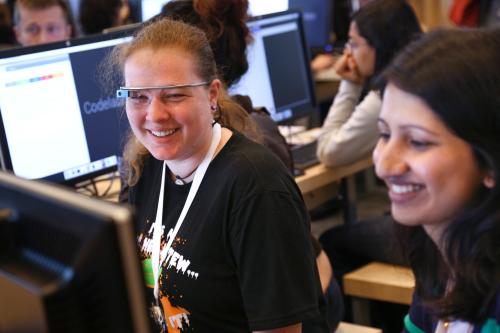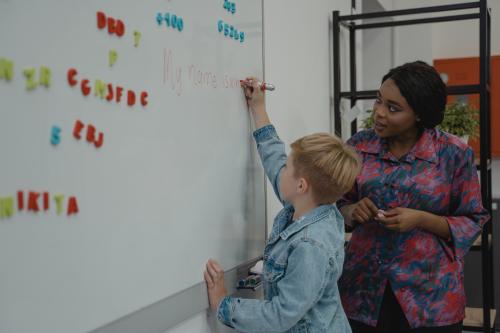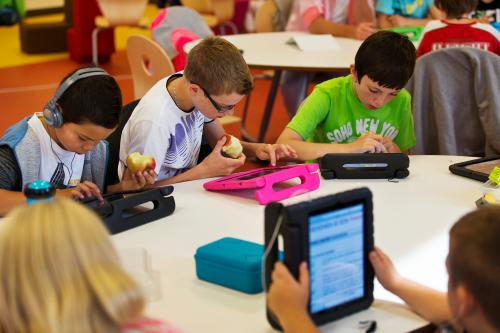Research consistently shows that effective teachers are the most important school-level factor influencing student outcomes. It therefore comes as no surprise that many education reform efforts focus on supporting and improving the teaching profession. At the same time, technology-focused initiatives continue to gain momentum in education—as seen through the White House’s ConnectEd Initiative and the more than 3,100 superintendents who have signed the Department of Education’s Future Ready pledge to increase student access to quality digital learning.
In the competition for scarce education dollars, these two advocacy camps sometimes conflict, especially if technology seems to be a play for cutting teacher jobs. But teachers and technology are only at odds when advocates from the respective camps fail to see technology’s critical role in complementing high-quality teaching.
In “Teaching in the Machine Age,” a paper recently published by the Clayton Christensen Institute, I provide general frameworks for thinking about the optimal roles teachers and technology should each play in schools of the future.
As the paper notes, many professions outside of education benefit from innovations that simplify and automate some of the tasks of experts, thereby freeing experts to spend more time and energy practicing at the top of their field. For example, MetaMind, a startup that develops artificial intelligence software, uses natural language processing, computer vision, and database prediction algorithms to analyze medical scans for tumors and lesions. Assisted by this technology, doctors no longer need to spend a lot of time scouring images for abnormalities. Instead, they can allocate that time to seeing patients and developing treatments.
Similarly, in the field of animation, computer animation technologies substitute for humans in performing laborious rules-based tasks such as manually drawing and coloring all the individual images in an animated sequence. But in doing so, they allow expert animators and artists to focus their time and creativity on tasks that cannot be automated, including imbuing characters with persona-forming appearances, movements, and gestures.
When it comes to education, computers’ speed and computational accuracy give them a comparative advantage for tasks such as assessing students’ knowledge of basic facts and skills, tracking students’ learning progress, presenting academic content, and adapting instruction to students’ individual learning needs. Meanwhile, good teachers are irreplaceable assets for coaching and mentoring students, addressing the social and emotional factors affecting students’ learning, and providing students with expert feedback on complicated human skills such as critical thinking, creative problem solving, communication, and project management.
Nonetheless, for some educators, these ideas of computer automation and task commoditization come across as threatening rhetoric aimed at displacing teachers. After all, many stories about the advent of smart machines are not as serendipitous as those of physicians and animators. One of the largest challenges facing our modern economy is figuring out how to find new employment for factory workers, taxi drivers, bank loan officers, retail clerks, and a host of other workers whose jobs are being eliminated by smart machines.
Yet, job displacement fears are unlikely to pan out in the teaching profession, given the very different skills needed to be a teacher. Innovations that automate and commoditize professional expertise only threaten the job security of professionals when their jobs consist entirely of complex yet rules-based tasks, such as preparing common tax returns or legal documents. For professionals whose jobs are full of higher-order tasks that cannot be reduced to rules-based instructions, innovations that simplify and automate professional expertise serve to enhance—rather than substitute for—experts’ abilities.
Given the many ways in which technology can enhance and amplify great teaching, I think the future of the profession looks incredibly bright. But that future depends on what we expect of our education system. If we task schools merely with helping students memorize basic facts and skills to pass bubble tests, then teaching will likely become entirely automated.
But if our goal is to help students develop deeper learning and 21st-century skills that they will need to thrive in modern society, then technology cannot eliminate the need for teachers. In fact, technology will be critical for enabling teachers to rise to the enormous responsibilities we place on their shoulders. As the paper points out, combining teachers and technology affords education leaders new options for addressing teacher shortages, providing students with differentiated instruction, and giving teachers capacity to focus on deeper learning and noncognitive skills.
Investing in teachers and technology should not be seen as “either/or” propositions. With recent advances in the science of teaching and in artificial intelligence, educators have unprecedented opportunities to redesign traditional instructional models and rethink traditional teaching roles in ways that amplify the impact of teachers. In short, let technology do what it does best so that teachers can focus on the teaching activities for which their human expertise is most needed.






Commentary
Choosing between teachers and technology
February 3, 2017